Arginine mutations within a transmembrane domain of Tar, an Escherichia coli aspartate receptor, can drive homodimer dissociation and heterodimer association in vivo
- PMID: 15330757
- PMCID: PMC1134670
- DOI: 10.1042/BJ20041022
Arginine mutations within a transmembrane domain of Tar, an Escherichia coli aspartate receptor, can drive homodimer dissociation and heterodimer association in vivo
Abstract
The interactions between the TM (transmembrane) domains of many membrane proteins are important for their proper functioning. Mutations of residues into positively charged ones within TM domains were reported to be involved in many genetic diseases, possibly because these mutations affect the self- and/or hetero-assembly of the corresponding proteins. To our knowledge, despite significant progress in understanding the role of various amino acids in TM-TM interactions in vivo, the direct effect of positively charged residues on these interactions has not been studied. To address this issue, we employed the N-terminal TM domain of the aspartate receptor (Tar-1) as a dimerization model system. We expressed within the ToxR TM assembly system several Tar-1 constructs that dimerize via polar- or non-polar amino acid motifs, and mutated these by replacement with a single arginine residue. Our results have revealed that a mutation in each of the motifs significantly reduced the ability of the TMs to dimerize. Furthermore, a Tar-1 construct that contained two arginine residues was unable to correctly integrate itself into the membrane. Nevertheless, an exogenous synthetic Tar-1 peptide containing these two arginine residues was able to inhibit in vivo the marked dimerization of a mutant Tar-1 construct that contained two glutamate residues at similar positions. This indicates that hetero-assembly of TM domains can be mediated by the interaction of two oppositely charged residues, probably by formation of ion pairs. This study broadens our knowledge regarding the effect of positively charged residues on TM-TM interactions in vivo, and provides a potential therapeutic approach to inhibit uncontrolled dimerization of TM domains caused by mutations of polar amino acids.
Figures
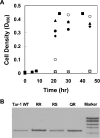

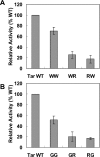
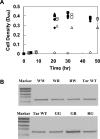
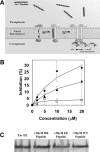

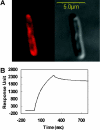
Similar articles
-
The composition rather than position of polar residues (QxxS) drives aspartate receptor transmembrane domain dimerization in vivo.Biochemistry. 2004 Mar 2;43(8):2309-13. doi: 10.1021/bi0356294. Biochemistry. 2004. PMID: 14979727
-
Hetero-assembly between all-L- and all-D-amino acid transmembrane domains: forces involved and implication for inactivation of membrane proteins.J Mol Biol. 2004 Nov 26;344(3):855-64. doi: 10.1016/j.jmb.2004.09.066. J Mol Biol. 2004. PMID: 15533450
-
The region preceding the C-terminal NWETF pentapeptide modulates baseline activity and aspartate inhibition of Escherichia coli Tar.Biochemistry. 2008 Dec 16;47(50):13287-95. doi: 10.1021/bi8013399. Biochemistry. 2008. PMID: 19053273
-
Role of GxxxG Motifs in Transmembrane Domain Interactions.Biochemistry. 2015 Aug 25;54(33):5125-35. doi: 10.1021/acs.biochem.5b00495. Epub 2015 Aug 13. Biochemistry. 2015. PMID: 26244771 Review.
-
Sequence conservation in Ig-like domains: the role of highly conserved proline residues in the fibronectin type III superfamily.J Mol Biol. 2002 May 10;318(4):935-40. doi: 10.1016/S0022-2836(02)00184-5. J Mol Biol. 2002. PMID: 12054791 Review.
Cited by
-
Novel ORAI1 Mutation Disrupts Channel Trafficking Resulting in Combined Immunodeficiency.J Clin Immunol. 2021 Jul;41(5):1004-1015. doi: 10.1007/s10875-021-01004-8. Epub 2021 Mar 1. J Clin Immunol. 2021. PMID: 33650027 Free PMC article.
-
Role of receptor tyrosine kinase transmembrane domains in cell signaling and human pathologies.Biochemistry. 2006 May 23;45(20):6241-51. doi: 10.1021/bi060609y. Biochemistry. 2006. PMID: 16700535 Free PMC article. Review.
-
Isolated Toll-like receptor transmembrane domains are capable of oligomerization.PLoS One. 2012;7(11):e48875. doi: 10.1371/journal.pone.0048875. Epub 2012 Nov 14. PLoS One. 2012. PMID: 23155421 Free PMC article.
-
The Third Transmembrane Domain of EscR Is Critical for Function of the Enteropathogenic Escherichia coli Type III Secretion System.mSphere. 2018 Jul 25;3(4):e00162-18. doi: 10.1128/mSphere.00162-18. mSphere. 2018. PMID: 30045964 Free PMC article.
-
Transmembrane helix dimerization: beyond the search for sequence motifs.Biochim Biophys Acta. 2012 Feb;1818(2):183-93. doi: 10.1016/j.bbamem.2011.08.031. Epub 2011 Sep 1. Biochim Biophys Acta. 2012. PMID: 21910966 Free PMC article. Review.
References
-
- Ding P. Z., Wilson T. H. The effect of modifications of the charged residues in the transmembrane helices on the transport activity of the melibiose carrier of Escherichia coli. Biochem. Biophys. Res. Commun. 2001;285:348–354. - PubMed
-
- Burnay M., Crambert G., Kharoubi-Hess S., Geering K., Horisberger J. D. Electrogenicity of Na,K- and H,K-ATPase activity and presence of a positively charged amino acid in the fifth transmembrane segment. J. Biol. Chem. 2003;278:19237–19244. - PubMed
-
- Xu Y., Kakhniashvili D. A., Gremse D. A., Wood D. O., Mayor J. A., Walters D. E., Kaplan R. S. The yeast mitochondrial citrate transport protein. Probing the roles of cysteines, Arg181, and Arg189 in transporter function. J. Biol. Chem. 2000;275:7117–7124. - PubMed
-
- Partridge A. W., Melnyk R. A., Deber C. M. Polar residues in membrane domains of proteins: molecular basis for helix-helix association in a mutant CFTR transmembrane segment. Biochemistry. 2002;41:3647–3653. - PubMed
-
- Partridge A. W., Therien A. G., Deber C. M. Missense mutations in transmembrane domains of proteins: phenotypic propensity of polar residues for human disease. Proteins. 2004;54:648–656. - PubMed
Publication types
MeSH terms
Substances
LinkOut - more resources
Full Text Sources
Other Literature Sources

